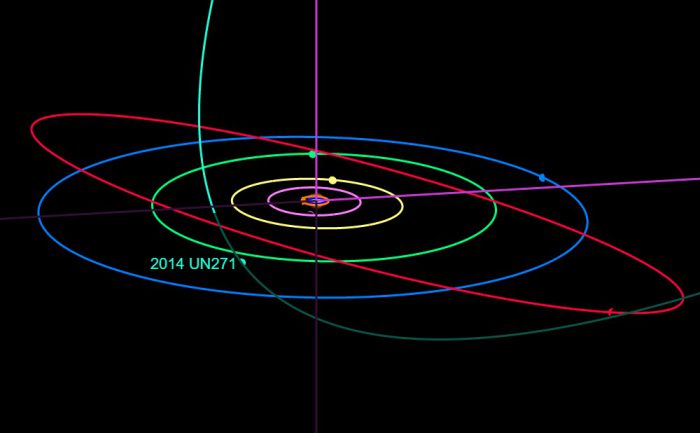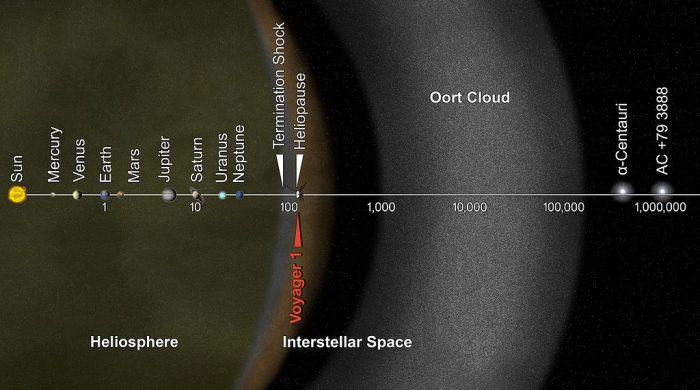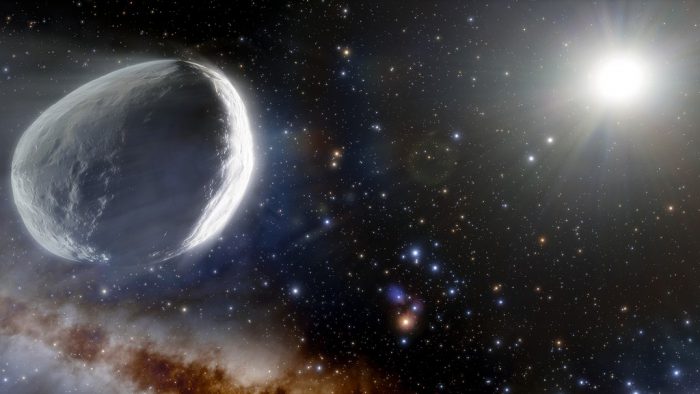A truly enormous comet is getting ready to visit and astronomers are rolling out the red carpet.
Called C/2014 UN271, or the Bernardinelli-Bernstein comet (after the astronomers that discovered it in 2014), it is a fantastically-sized visitor from the very outer depths of our solar system—the Oort Cloud. Though only recently found, astronomers have been able to piece together its orbit and they estimate that it has not been this close to the Sun in around three million years.
This combination of size, distant origins, and rare visits has experts extremely excited. Fortunately, they have until 2031 to get prepared. This is when the comet will make its nearest approach. If you're feeling worried, don't be. That approach will still only bring it as near as Saturn's orbit. Whew!
Let's take a look at this rare object and dig into what makes it so cool.
Hey there, big fella!

An diagram of the estimated orbit of the comet. As you can see, it stretches way out there! (Wikimedia Commons)
What does it take to be known as an 'enormous comet'?
When C/2014 UN271 was first found, astronomers thought it might be a new dwarf planet. Its diameter is an incredible 155 kilometres (96 miles). In comet terms, that's 14 times the size of Halley's Comet (11 km, 7 miles) and over the twice the size of Hale-Bopp (60 km, 37 miles), which is one of the brightest comets ever observed from Earth.
In terms of distances on Earth, that's about the flying distance between Halifax and Moncton. That is one, well, enormous comet!
All about Oort?

Though not to scale (or actual relative size), this is the position of the Oort Cloud. In reality, the orbit of Neptune is size of a poppy seed compared to the beach-ball sized Oort! (Wikimedia Commons)
So we know it's large. But what about where it's from?
We'd love to tell you all about the Oort Cloud, but the truth is that we don't know a lot about it. That's why this visit is so thrilling. It's rare to have something from that far out come so close.
What we do know is that this region of space represents the outer limit of our solar system. It is estimated to begin around 2,000 au from the Sun and end over 100,000 au away. (An au is an astronomical unit—one au is the distance of Earth to the Sun, or 150 million kilometres or 93 million miles.) In other words, it is a long way out there!
The Oort Cloud covers such a vast area that it is likely home to billions of comets of all sizes. The theory is that much of this material was formed close to the Sun during the early days of the solar system, but that it was then scattered far away over billions of years.
Let's get a look at you
At such a distance from Earth—and with most of the comets being fairly small—it is a real challenge to study the Oort cloud. But occasionally, forces outside our solar system can affect the orbit of comets and send them hurtling closer to the Sun. This may be why the Bernardinelli-Bernstein comet is making its way in our direction.
Regardless, astronomers know a gift when they see it. They're doing all they can to be ready to study it with telescopes when 2031 arrives. What questions will it help answer about the Oort? We'll just have to wait and see!
 An artist's illustration of what the Bernardinelli-Bernstein comet might look like. (Wikimedia Commons/NOIRLab/NSF/AURA/J. da Silva)
An artist's illustration of what the Bernardinelli-Bernstein comet might look like. (Wikimedia Commons/NOIRLab/NSF/AURA/J. da Silva)










will we be able to see it from Western Canada? 😛
Incredible comet! It has come from so far away we should give it a warm welcome!
😳 ❓ 🙄 😎 😛 😮 ❗ ❗ ❗ 🙄 😮 😀 🙂 🙂 🙂 😉 😮 😛